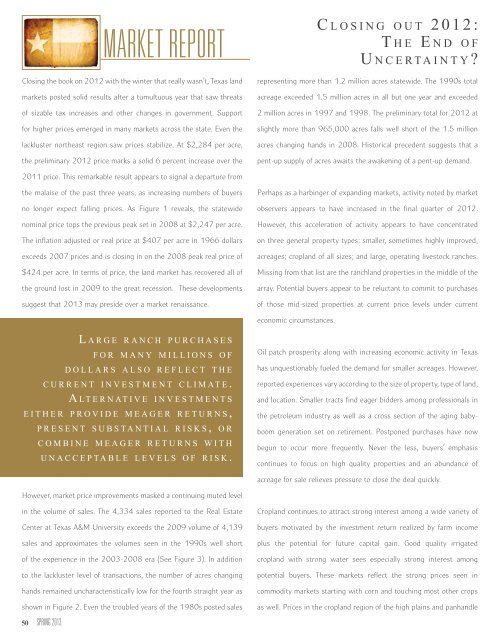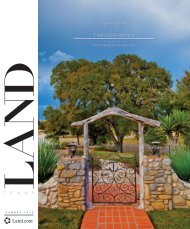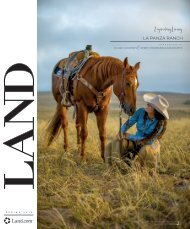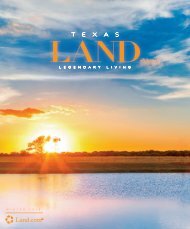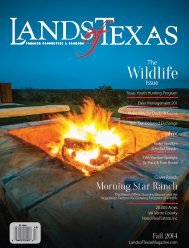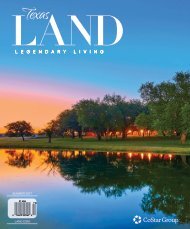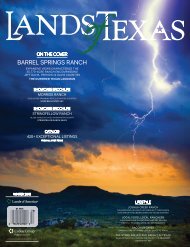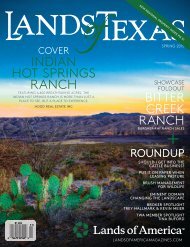You also want an ePaper? Increase the reach of your titles
YUMPU automatically turns print PDFs into web optimized ePapers that Google loves.
MARKET REPORT<br />
Closing the book on 2012 with the winter that really wasn’t, <strong>Texas</strong> land<br />
markets posted solid results after a tumultuous year that saw threats<br />
of sizable tax increases and other changes in government. Support<br />
for higher prices emerged in many markets across the state. Even the<br />
lackluster northeast region saw prices stabilize. At $2,284 per acre,<br />
the preliminary 2012 price marks a solid 6 percent increase over the<br />
C l o s i n g o u t 2 0 1 2 :<br />
T h e E n d o f<br />
U n c e r t a i n t y ?<br />
representing more than 1.2 million acres statewide. The 1990s total<br />
acreage exceeded 1.5 million acres in all but one year and exceeded<br />
2 million acres in 1997 and 1998. The preliminary total for 2012 at<br />
slightly more than 965,000 acres falls well short of the 1.5 million<br />
acres changing hands in 2008. Historical precedent suggests that a<br />
pent-up supply of acres awaits the awakening of a pent-up demand.<br />
2011 price. This remarkable result appears to signal a departure from<br />
the malaise of the past three years, as increasing numbers of buyers<br />
no longer expect falling prices. As Figure 1 reveals, the statewide<br />
nominal price tops the previous peak set in 2008 at $2,247 per acre.<br />
The inflation adjusted or real price at $407 per acre in 1966 dollars<br />
exceeds 2007 prices and is closing in on the 2008 peak real price of<br />
$424 per acre. In terms of price, the land market has recovered all of<br />
the ground lost in 2009 to the great recession. These developments<br />
suggest that <strong>2013</strong> may preside over a market renaissance.<br />
Perhaps as a harbinger of expanding markets, activity noted by market<br />
observers appears to have increased in the final quarter of 2012.<br />
However, this acceleration of activity appears to have concentrated<br />
on three general property types: smaller, sometimes highly improved,<br />
acreages; cropland of all sizes; and large, operating livestock ranches.<br />
Missing from that list are the ranchland properties in the middle of the<br />
array. Potential buyers appear to be reluctant to commit to purchases<br />
of those mid-sized properties at current price levels under current<br />
economic circumstances.<br />
L a r g e r a n c h p u r c h a s e s<br />
f o r m a n y m i l l i o n s o f<br />
d o l l a r s a l s o r e f l e c t t h e<br />
c u r r e n t i n v e s t m e n t c l i m at e .<br />
A lt e r n at i v e i n v e s t m e n t s<br />
e i t h e r p r o v i d e m e a g e r r e t u r n s ,<br />
p r e s e n t s u b s t a n t i a l r i s k s , o r<br />
c o m b i n e m e a g e r r e t u r n s w i t h<br />
u n a c c e p t a b l e l e v e l s o f r i s k .<br />
Oil patch prosperity along with increasing economic activity in <strong>Texas</strong><br />
has unquestionably fueled the demand for smaller acreages. However,<br />
reported experiences vary according to the size of property, type of land,<br />
and location. Smaller tracts find eager bidders among professionals in<br />
the petroleum industry as well as a cross section of the aging babyboom<br />
generation set on retirement. Postponed purchases have now<br />
begun to occur more frequently. Never the less, buyers’ emphasis<br />
continues to focus on high quality properties and an abundance of<br />
acreage for sale relieves pressure to close the deal quickly.<br />
However, market price improvements masked a continuing muted level<br />
in the volume of sales. The 4,334 sales reported to the Real Estate<br />
Center at <strong>Texas</strong> A&M University exceeds the 2009 volume of 4,139<br />
sales and approximates the volumes seen in the 1990s well short<br />
of the experience in the 2003-2008 era (See Figure 3). In addition<br />
to the lackluster level of transactions, the number of acres changing<br />
hands remained uncharacteristically low for the fourth straight year as<br />
shown in Figure 2. Even the troubled years of the 1980s posted sales<br />
50 SPRING <strong>2013</strong><br />
Cropland continues to attract strong interest among a wide variety of<br />
buyers motivated by the investment return realized by farm income<br />
plus the potential for future capital gain. Good quality irrigated<br />
cropland with strong water sees especially strong interest among<br />
potential buyers. These markets reflect the strong prices seen in<br />
commodity markets starting with corn and touching most other crops<br />
as well. Prices in the cropland region of the high plains and panhandle


